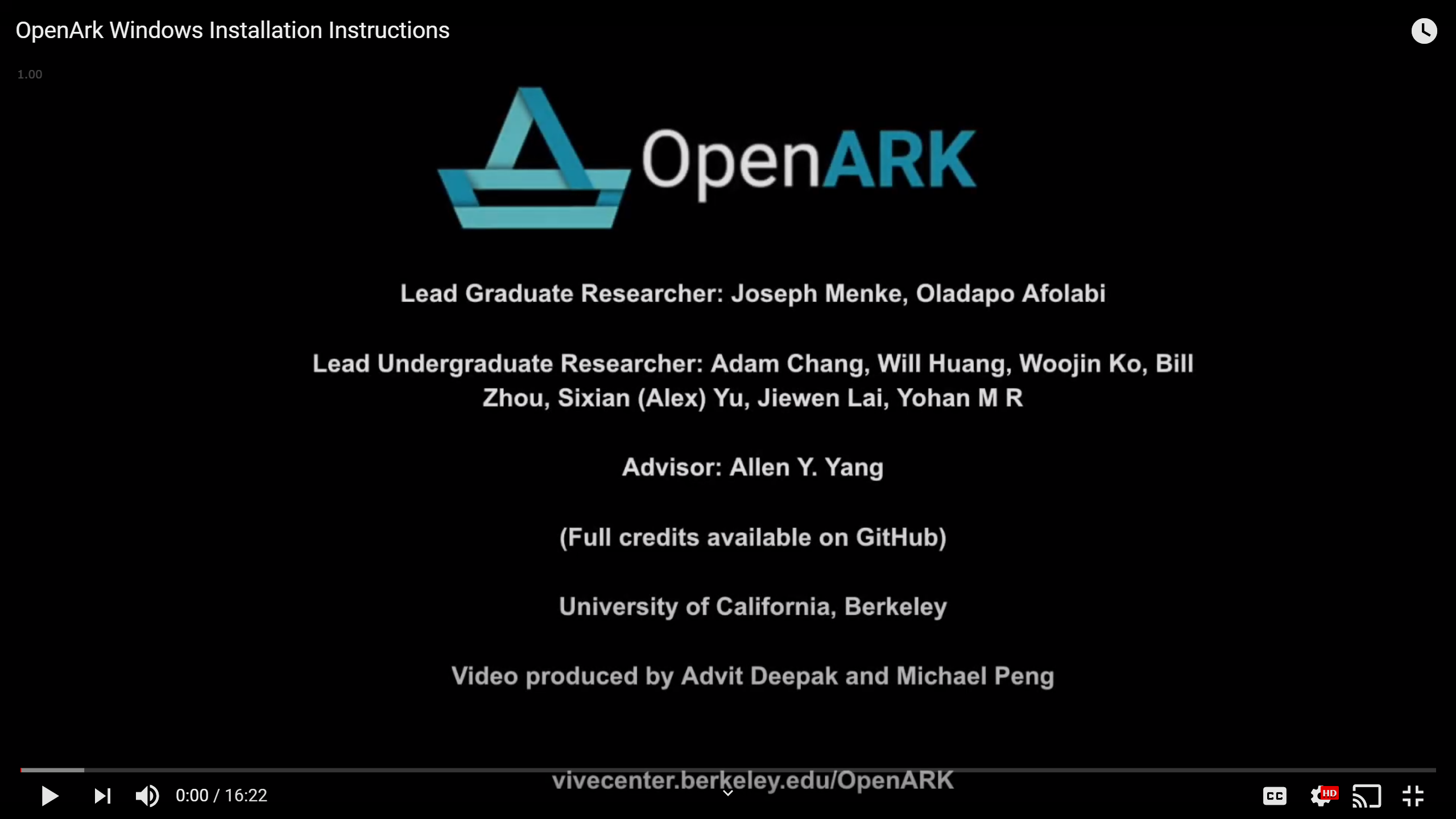OpenARK is an open-source wearable augmented reality (AR) system founded at UC Berkeley in 2016. The C++ based software offers innovative core functionalities to power a wide range of off-the-shelf AR components, including see-through glasses, depth cameras, and IMUs. The open-source platform includes higher-level modules to aid human-computer interaction, such as 3D gesture recognition, plane detection, avatar/pose tracking, and multi-user collaboration, and also contains fundamental tools such as AR-based camera calibration, depth-to-stereo, and SLAM, and 3D Reconstruction. Currently, it supports both PMD Pico Flexx and Intel RealSense SR300 cameras. The project builds natively on both Windows and Linux.
- Technology stack: C++, OpenCV, PCL, Boost, Intel RealSense SDK (1 or 2) / PMD SDK
- Status: Beta 0.9.3
- Application Demos: Vive Center
- Depth Camera
- RGB Camera
- Transparent AR Glasses (optional)
- Eigen 3
- OpenCV 3.2.0+
- PCL 1.8
- Boost 1.6.4
- Ceres-solver
- DBoW2
- etc. for the full list, see DEPENDENCIES.md
New: a dependency pack installer is now available, which accelerates the setup process. Please read documentation/Windows-build-instructions-quick.md for instructions. The installer may be found here.
New: Click below for the Youtube build tutorial that can help guide you through the accelerated install process, though the written instructions will be updated more frequently.
Check the following installation document for OpenARK for Windows : documentation/Windows-build-instructions.pdf
Prebuilt binaries for 64-bit Windows are available here. This is only updated for major releases.
Both the static library (with the headers) and the demo program are included. For the SVM to work properly, the svm/ folder must be present in the current directory OR under the directory pointed to by the OPENARK_DIR environment variable.
Check the following installation document for OpenARK for Linux : documentation/Linux-build-instructions.md
To use the avatar module/demo, please download the SMPL model files manually. The instructions are in data/avatar-model/README.md.
You may also download the dataset sample by running data/avatar-dataset/download.sh.
To use OpenARK in a Visual Studio C++ project:
After setting up all the dependencies (OpenCV, PCL, etc.) according the configuration instructions, add openark_x_x_x.lib to Project > MyProjectProperties > Linker > Input > Additional Dependencies. Then add OPENARK_DIR/include to C/C++ > General > Additional Include Directories. Finally, make sure that under C/C++ > Code Generation, Runtime Library is set to Multi-threaded DLL (/MD).
Now you can #include OpenARK's core header in any file and begin using OpenARK. You would probably also want to include one of the depth camera backend headers (e.g. SR300Camera.h).
Here is the outline of a program for performing hand detection:
...
#include "core.h"
#include "SR300Camera.h"
#include "opencv2/core.hpp"
#include <vector>
...
int main() {
ark::DepthCamera & camera = ark::SR300Camera(); // OpenARK camera backend
ark::HandDetector detector(); // OpenARK hand detector; also see PlaneDetector
// start the camera; alternatively, call nextFrame() manually inside the loop (slower)
camera.beginCapture();
...
while (true) {
cv::imshow("XYZ Map", camera.getXYZMap());
detector.update(camera);
std::vector<ark::Hand::Ptr> hands = detector.getHands();
// do something with the hands detected
...
// quit when q is pressed
if (cv::waitKey(1) == 'q') break;
}
...
// automatically stops capture on exit
}Additional sample code is available in samplecode/.
OpenARK is made for easy customization. Please feel free to build on top of this platform to fit your needs.
Code used to run the demo video is included in HandDemo.cpp. Additional sample code can be found in /samplecode/ and you would need to replace it with the main that comes with the project solution.
Currently OpenARK only supports the Intel Realsense D435i Camera for use with OpenARK SLAM. OpenARK SLAM requires two configuration files to run, a camera intrinsics file, and a vocab file. Examples of both files can be found in the config folder. To run the OpenARK SLAM Demo run:
OpenARK_SLAM_demo.exe <intrinsics file> <vocab file>
While the vocab file provided should work for most purposes, for best performance a custom intrinsics file should be generated for each camera. You can generate a custom intrinsics file for your camera by running
d435i_intrinsics_writer <camera name>
This will generate a complete intrinsics file named <camera name>_intr.yaml
OpenARK SLAM heavily utilizes the open source packages DBoW2, Okvis, and Ceres. Please respect their Licences and credit/cite when appropriate.
Currently OpenARK only supports the Intel Realsense D435i Camera for use with OpenARK 3D Reconstruction. OpenARK 3D Reconstruction requires two configuration files to run, a camera intrinsics file, and a vocab file. Examples of both files can be found in the config folder. It also accepts a frame output directory, which defaults to /frames/. To run the OpenARK 3D Reconstruction Demo run:
3dRecon_Data_Recording.exe <intrinsics file> <vocab file> <frame directory>
While the vocab file provided should work for most purposes, for best performance a custom intrinsics file should be generated for each camera. You can generate a custom intrinsics file for your camera by running
d435i_intrinsics_writer <camera name>
This will generate a complete intrinsics file named <camera name>_intr.yaml
Offline reconstruction can be performed on the recorded data output of the application using the Python script located in /scripts/OfflineReconstruction.py.
OpenARK 3D Reconstruction heavily utilizes the open source packages DBoW2, Okvis, Open3D, and Ceres. Please respect their Licences and credit/cite when appropriate.
OpenCV prior to 3.2.0 does not offer prebuilt VC14+ binaries. Running VC12 OpenCV binaries with VC14 will result in memories errors in findCountours(). If you are using VC12+ to compile OpenARK, you will need to use CMake to rebuilt OpenCV from source. We have used OpenCV 3.2.0 which comes with OpenCV binaries for VC14 to avoid this problem when using Visual Studio 2015.
If you have questions, concerns, bug reports, etc, please file an issue in this repository's Issue Tracker.
The Center for Augmented Cognition welcomes interested industry partners to join our alliance to support the OpenARK platform. More information can be found on cac.berkeley.edu
Bill Zhou, Allen Y. Yang, S. Shankar Sastry, Will Huang, Larry Yang, Eric Nguyen, Michelli Ni, Peter Li, Jessica Jiang, Mona Jalal, Joseph Menke, Lawrence Chen, Kuan Lu, Rachel Lee, Justin Yang, Alex Yu, Adam Chang, Woojin Ko
